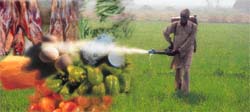The Silent killer
 T he pesticide threat first emerged in the West, the us in particular. In the early 1930s, the Dutch elm disease spread across the us. A fungus disease spread by beetles, it proved fatal to trees, blocking their water-conducting vessels. In 1954, us farmers began spraying ddt to kill the beetles in a bid to curb the disease. But the pesticide soon affected robins, killing thousands of birds.
T he pesticide threat first emerged in the West, the us in particular. In the early 1930s, the Dutch elm disease spread across the us. A fungus disease spread by beetles, it proved fatal to trees, blocking their water-conducting vessels. In 1954, us farmers began spraying ddt to kill the beetles in a bid to curb the disease. But the pesticide soon affected robins, killing thousands of birds.
Then, in 1963, came Silent Spring , a landmark book by environmentalist Rachel Carson, which detailed how increased pesticide use affected bird population in the us , sometimes wiping out entire population and even species. Her emotive assessment of the situation
Related Content
- Air pollution claims 7 million lives each year: UN expert
- Hepatitis C: The silent killer
- This SILENT KILLER affects 1 in every 8 Indian above the age of 30
- The Silent Killer: Climate Change and the Health Impacts of Extreme Heat
- Pollution, the silent killer
- CSE condemns misrepresentation of findings of recent CSIR study on diesel and CNG buses
